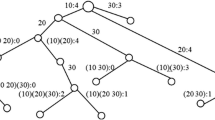Abstract
This paper presents the PlanMine sequence mining algorithm to extract patterns of events that predict failures in databases of plan executions. New techniques were needed because previous data miningalgorithms were overwhelmed by the staggering number of very frequent,but entirely unpredictive patterns that exist in the plan database.This paper combines several techniques for pruning out unpredictiveand redundant patterns which reduce the size of the returned rule setby more than three orders of magnitude. PlanMine has also beenfully integrated into two real-world planning systems. We experimentally evaluate the rules discovered by PlanMine, and show that theyare extremely useful for understanding and improving plans, as wellas for building monitors that raise alarms before failures happen.
Similar content being viewed by others
References
Agrawal, R. & Shafer, J. (1996). Parallel Mining of Association Rules. IEEE Trans. on Knowledge and Data Engg. 8(6): 962-969.
Agrawal, R. & Srikant, R. (1995). Mining Sequential Patterns. In 11th Intl. Conf. on Data Engg.
Agrawal, R., Mannila, H., Srikant, R., Toivonen, H. & Verkamo, A. I. (1996). Fast Discovery of Association Rules. In Fayyad, U. and et al. (eds.) Advances in Knowledge Discovery and Data Mining, 307-328. AAAI Press, Menlo Park, CA.
Ali, K., Manganaris, S. & Srikant, R. (1997). Partial Classification using Association Rules. In 3rd Int'l Conference on Knowledge Discovery in Databases and Data Mining.
Bayardo, R.J. (1997). Brute-force Mining of High-confidence Classification Rules. In 3rd Intl. Conf. on Knowledge Discovery and Data Mining.
Breiman, L., Friedman, J.H., Olshen, R.A. & Stone, C.J. (1984). Classification and Regression Trees. Belmont: Wadsworth.
Fayyad, U., Piatetsky-Shapiro, G., Smyth, P. & Uthurusamy, R. (1996). Advances in Knowledge Discovery and Data Mining. AAAI Press, Menlo Park, CA.
Fayyad, U., Piatetsky-Shapiro, G. & Smyth, P. (1996). From Data Mining to Knowledge Discovery: An Overview. In Advances in Knowledge Discovery and Data Mining.(1996).
Ferguson, G. & James, A. (1998). TRIPS: An Integrated Intelligent Problem-Solving Assistant. In 15th Nat. Conf. AI.
Gunopulos, D., Khardon, R., Mannila, H. & Toivonen, H. (1997). Data Mining, Hypergraph Transversals, and Machine Learning. In 16th ACMSymp. Principles of Database Systems.
Haigh, K.Z. & Veloso, M.M. (1998). Learning Situation-dependent Costs: Improving Planning from Probabilistic Robot Execution. In Intl. Conf. Autonomous Agents.
Hammond, K. (1990). Explaining and Repairing Plans that Fail. J. Artificial Intelligence 45: 173-228.
Han, J. & Fu, Y. (1995). Discovery of Multiple-level Association Rules from Large Databases. In 21st VLDB Conf.
Hatonen, K., Klemettinen,M., Mannila, H., Ronkainen, P. & Toivonen, H. (1996). Knowledge Discovery from Telecommunication Network Alarm Databases. In 12th Intl. Conf. Data Engineering.
Howe, A.E. & Cohen, P.R. (1995). Understanding Planner Behavior. J. Artificial Intelligence 76(1): 125-166.
Klemettinen, M., Mannila, H., Ronkainen, P., Toivonen, H. & Verkamo, A.I. (1994). Finding Interesting Rules from Large Sets of Discovered Association Rules. In 3rd Intl. Conf. Information and Knowledge Management, 401-407.
Kushmerick, N., Hanks, S. & Weld, D. (1995). An Algorithm for Probabilistic Planning. J. Artificial Intelligence 76: 239-286.
Lesh, N., Martin, N. & Allen, J. (1998). Improving Big Plans. In 15th Nat. Conf. AI.
Mannila, H. & Toivonen, H. (1996). Discovering Generalized Episodes Using Minimal Occurences. In 2nd Intl. Conf. Knowledge Discovery and Data Mining.
Mannila, H., Toivonen, H. & Verkamo, I. (1995). Discovering Frequent Episodes in Sequences. In 1st Intl. Conf. Knowledge Discovery and Data Mining.
McDermott, D. (1994). Improving Robot Plans during Execution. In 2nd Intl. Conf. AI Planning Systems, 7-12.
Minton, S. (1990). Quantitative Results Concerning the Utility of Explanation-based Learning. Artificial Intelligence 42(2-3).
Oates, T. & Cohen, P. R. (1996). Searching for Planning Operators with Context-dependent and Probabilistic Effects. In 13th Nat. Conf. AI.
Oates, T., Schmill, M.D., Jensen, D. & Cohen, P.R. (1997). A Family of Algorithms for Finding Temporal Structure in Data. In 6th Intl. Workshop on AI and Statistics.
Reece, G. & Tate, A. (1994). Synthesizing Protection Monitors from Causal Structure. In 2nd Intl. Conf. AI Planning Systems.
Riddle, P., Segal, R. & Etzioni, O. (1994). Representation Design and Brute-force Induction in a Boeing Manufacturing Domain. Applied Aritficial Intelligence 8: 125-147.
Srikant, R. & Agrawal, R. (1995). Mining Generalized Association Rules. In 21st VLDB Conf.
Srikant, R. & Agrawal, R. (1996a). Mining Quantitative Association Rules in Large Relational Tables. In ACM SIGMOD Conf. Management of Data.
Srikant, R. & Agrawal, R. (1996b). Mining Sequential Patterns: Generalizations and Performance Improvements. In 5th Intl. Conf. Extending Database Technology.
Zaki, M.J., Parthasarathy, S., Ogihara, M. & Li, W. (1997a). New Algorithms for Fast Discovery of Association Rules. In 3rd Intl. Conf. on Knowledge Discovery and Data Mining.
Zaki,M.J., Parthasarathy, S., Ogihara,M. & Li,W. (1997b). New Parallel Algorithms for Fast Discovery of Association Rules. Data Mining and Knowledge Discovery: An International Journal 1(4): 343-373.
Zaki,M.J., Lesh, N. & Ogihara, M. (1998). PLANMINE: Sequence Mining for Plan Failures. In 4th Intl. Conf. Knowledge Discovery and Data Mining.
Zaki, M.J. (1998). Efficient Enumeration of Frequent Sequences. In 7th Intl. Conf. on Information and Knowledge Management.
Author information
Authors and Affiliations
Rights and permissions
About this article
Cite this article
Zaki, M.J., Lesh, N. & Ogihara, M. PlanMine: Predicting Plan Failures Using Sequence Mining. Artificial Intelligence Review 14, 421–446 (2000). https://doi.org/10.1023/A:1006612804250
Issue Date:
DOI: https://doi.org/10.1023/A:1006612804250




